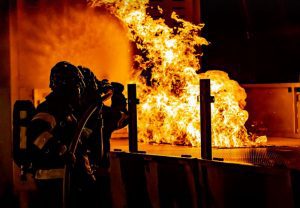What is Passive Fire Protection?
In today’s world, building safety is paramount. Passive fire protection is a crucial element that contributes significantly to ensuring the safety of occupants in case of a fire.
So, what exactly is passive fire protection?
Passive fire protection (PFP) refers to a set of permanent building features designed to slow or prevent the spread of fire and smoke within a building. These features, like fire-resistant walls, doors, and partitions, work without any external activation, relying on the inherent fire-resistant properties of the materials used.
The primary goals of passive fire protection are:
 Compartmentalization: PFP measures help compartmentalize buildings by dividing them into separate zones using fire-resistant walls, floors, and ceilings. This compartmentalization restricts the spread of fire and smoke to the area of origin, allowing occupants more time to evacuate safely. You can find more details on fire safety measures for buildings in our page on fire safety measures.
Compartmentalization: PFP measures help compartmentalize buildings by dividing them into separate zones using fire-resistant walls, floors, and ceilings. This compartmentalization restricts the spread of fire and smoke to the area of origin, allowing occupants more time to evacuate safely. You can find more details on fire safety measures for buildings in our page on fire safety measures.- Structural stability: Passive fire protection systems are designed to maintain the structural integrity of a building during a fire. This ensures that essential elements like beams, columns, and load-bearing walls remain stable for a predetermined period, allowing for safe evacuation and preventing the collapse of the structure.
- Life safety: By containing the fire and smoke, passive fire protection systems create safer conditions for building occupants to evacuate during a fire emergency.
Examples of Passive Fire Protection Systems:
There’s a wide range of passive fire protection systems used in buildings. Here are some common examples:
- Fire-resistant walls, partitions, and ceilings are crucial elements. These elements are constructed using non-combustible or fire-resistant materials like drywall, concrete, or specialized fire boards.
- Fire doors and doorsets: These specially designed doors are crucial for compartmentalization and can withstand fire for a specific duration, allowing for safe passage during an evacuation.
- Fire stopping: This involves sealing openings in walls, floors, and ceilings with fire-resistant materials to prevent the spread of fire, smoke, and hot gases through these penetrations. Learn more about our fire stopping services on a dedicated page.
- Steel fire protection: Steel is a strong building material, but it loses its strength at high temperatures. Steel fire protection involves applying fire-resistant coatings or cladding to steel beams and columns to ensure structural stability during a fire. We offer a range of steel fire protection services to ensure your building’s steel structure remains safe.
Importance of Passive Fire Services:
Passive fire protection plays a vital role in fire safety strategies. By implementing these measures, building owners and managers can significantly enhance the safety of occupants, minimize property damage, and ensure compliance with fire safety regulations.
LPP Fire Protection Specialists – Your Partner in Passive Fire Services:
LPP Fire Protection Specialists are experts in providing a comprehensive range of passive fire solutions. We offer services that include fire-resistant walls, doors, and partitions, fire stopping installations, steel fire protection, and more. Our team of qualified professionals can help you design, install, and maintain a robust passive fire system for your building, ensuring the safety of your occupants and meeting all regulatory requirements.
Don’t Compromise on Fire Safety: Choose Accredited PFP Solutions
For your passive fire protection systems to function effectively in a fire, using products and services from accredited providers is crucial. These providers undergo rigorous assessments by recognized bodies like BMT, ensuring the quality and performance of their PFP solutions. By choosing accredited PFP solutions, you guarantee your building’s fire protection meets the highest standards, potentially saving lives and minimizing property damage in the event of a fire.
Contact LPP Fire Protection Specialists today for a free consultation and learn how we can help you achieve optimal fire safety in your building.
